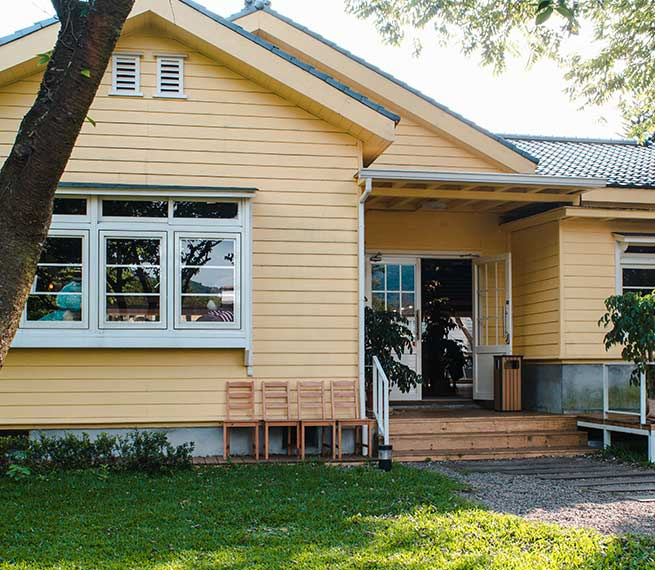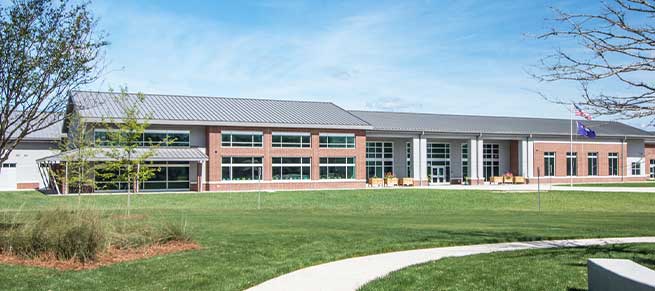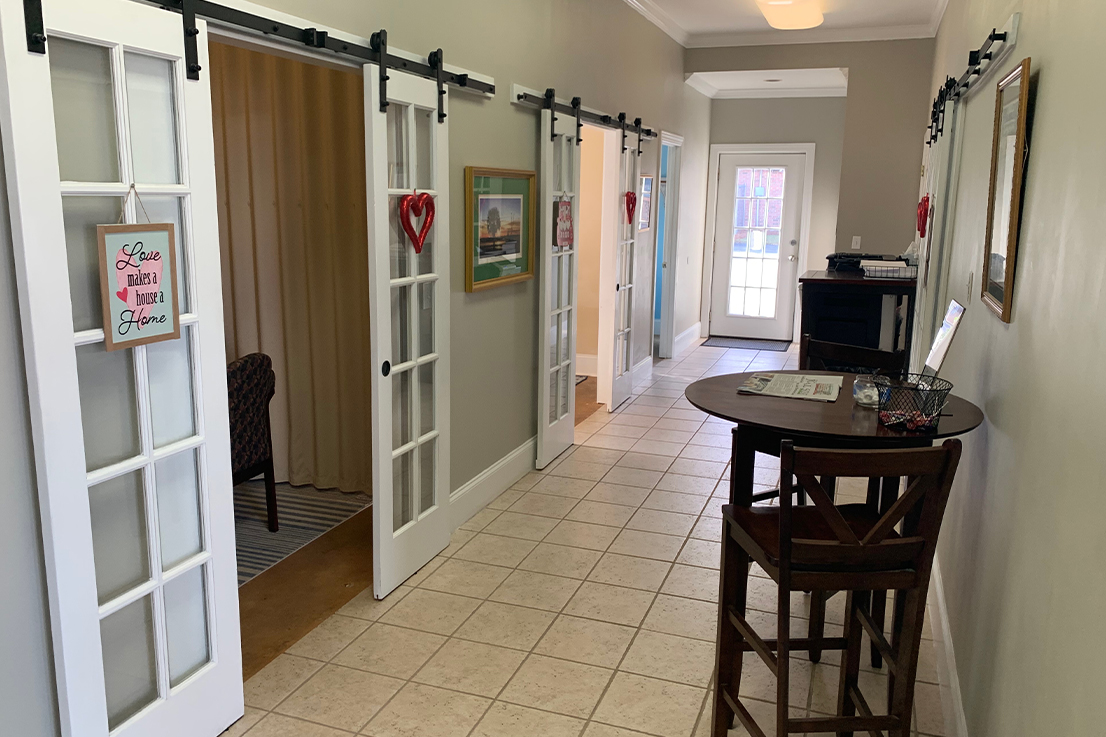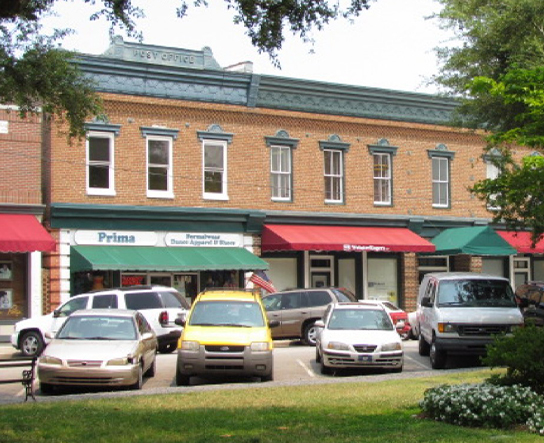Discover the Top Real Estate Agent in Summerville, SC
Buying or selling a home is a big deal. When it comes to making one of the largest financial decisions in your life, it's crucial to have a trusted advisor by your side. Someone who does what is best for you and your family, listens to your needs and does everything possible to help you achieve your goals. While most home buyers and sellers crave the same guidance from their real estate professionals, their specific real estate needs will always be different.
If you have been looking for a real estate agent who understands the delicate balance between the two, look no further than Hillary Jones. With more than 15 years of real estate experience under her belt, Hillary brings a unique set of client-centric skills to the table. Unlike some big box firms out there, Hillary provides personalized, one-on-one real estate services to all her clients. This boutique approach lets Hillary spend more time with clients, whether it's giving a house tour or finding the hidden gem of their dreams.
Hillary takes pride in knowing The Ponds, SC neighborhoods like the back of her hand, from new homes for sale in The Ponds neighborhood in Summerville, SC to secluded riverfront properties off the beaten path. She will work closely with you to discover the exact type of home you're interested in buying while always considering your budget.
Why do so many home buyers trust Hillary? She knows that the most important real estate transaction is yours. As such, she works tirelessly to exceed expectations.

Here are just a few more reasons why real estate clients trust Hillary Jones:
- 15+ Years of Real Estate Experience
- Always Working for Your Best Interests
- Expert Negotiator
- Loyal, Confident, and Capable
- Always Accessible Via Email or Phone
- Always Up to Date on Market Trends and What They Mean to You
- Expert at Writing Strong, Enforceable Contracts
- Well Connected
- Access to Many Homes for Sale in Dozens of Neighborhoods
- Stress-Free Service: You've Got Enough on Your Plate!
- Available Every Step of the Way, Even After Closing

Peaceful Living
Community designers chose to focus on a peaceful community atmosphere when creating this neighborhood. Homes are not stacked on top of one another but are also close enough to create a sense of community. Here, residents live, work, play, and gather while never being too far away from major thoroughfares. The neighborhood's layout helps reduce on-road traffic, encouraging alternative methods of travel like walking and biking.
The community plan sidewalks and beautiful spaces for residents to enjoy, creating meaningful ties to Mother Nature. With gorgeous walking and biking trails nearby, residents have the chance to enjoy natural features without having to travel to a national park.
If living close to nature in a community-based environment sounds like the perfect place to live, The Ponds neighborhood in Summerville, SC should be high on your list.
Schools

Schooling is important to the residents of Summerville, SC, with the community being close to many of the area's highest-ranking K-12 schools. If you have younger children, you will love the local education system and pre-K options for younger kids. Local high schools are also great, and feature many course options with purpose-driven curriculums and over-achieving teachers. During your tour of this The Ponds neighborhood in Summerville, SC, be sure to ask Hillary Jones about the elementary, middle, and high school options for learning.
Crime Rate

Crime is always a factor no matter where you live, but if you're concerned about criminal activity in this The Ponds neighborhood in Summerville, SC, you don't have much to worry about. Recent statistics show that Summerville, SC has lower crime rates than other cities in South Carolina. That is great news if you're looking to buy a home in the next year, especially if you have younger children. If you're looking for a peaceful place to live with excellent nearby schools and lower than average crime rates, look no further than this popular neighborhood in Summerville, SC.

Homes for Sale The Ponds neighborhood in Summerville, SC
The Ponds neighborhood in Summerville, SC is a well-established neighborhood nestled in Summerville, SC - one of the most popular cities to live and play in in South Carolina. After spending some time in this gorgeous community, you will get a true sense of comfort and belonging here. You get the feeling that everything is well looked after and that residents are happy - because both are true.
in The Ponds neighborhood in Summerville, SC was designed to give residents access to everything they could want or need without driving all over Summerville, SC. Located a short driving distance from the highway, The Ponds neighborhood in Summerville, SC features unique recreation opportunities, shopping, top-ranked schools, and even healthcare, all within driving distance of the neighborhood. Community developers created the layout of this neighborhood in Summerville, SC with convenience and comfort in mind. When you live here, you can enjoy an abundance of trees, shrubs, walking trails, well-lit streets, and more.
A few reasons why home buyers put The Ponds neighborhood in Summerville, SC at the top of their lists include:
The Trail System

Designed for families and their children to get outside and play, in Summerville, SC trail system winds its way throughout the neighborhood, giving residents an easy way to get out and get exercise. Kids love to explore these trails, and parents love to let them get a break from sitting in front of their iPad all day. Adults enjoy the trails too, and use them for walking with friends, running, or simply meandering through The Ponds neighborhood in Summerville, SC.
Sense of Community

The The Ponds neighborhood in Summerville, SC designers wanted to give residents plenty of room to "stretch out" while also creating a palpable sense of community. So, you won't have to walk a mile in the snow to get a cup of sugar from your neighbor. On the other hand, residents and their lots are well-spaced apart, maintaining privacy. Residents in the The Ponds neighborhood in Summerville, SC neighborhood are close-knit, and very welcoming to new homeowners. If you have children, you should set up a date and time to tour The Ponds neighborhood in Summerville, SC with Hillary Jones, who can point out popular features and home plans.
Summerville, SC YMCA

One of the most sought-after amenities Summerville, SC is the family YMCA. This massive complex was created to give local residents a fun, easy way to enjoy recreation with friends and family. Features include modern exercise equipment, walking tracks, tennis and basketball courts, a softball field, an aquatics complex, and even wellness and health programs. Sign your child up for Summerville, SC camp, or even try learning a new sport to keep you active on the weekends!
Healthcare

Access to healthcare options in Summerville, SC is plentiful and located within a few miles' drive. Healthcare providers include:
- Primary Care Options
- Orthodontic Practices
- Family Dentistry Offices
- Chiropractic and Massage Therapists
- Assisted Living Facilities
- Eye Care Centers
Shopping

One of the biggest reasons why so many home buyers settle on Summerville, SC is the extensive access to shops and services, all located just a short drive from the neighborhood.
Shopping and convenience options include:
- Popular grocery store chains
- Restaurants offering breakfast, lunch, and dinner options from names like Starbucks and Chick-Fil-A, and more.
- Gas stations and convenience stores for re-fueling and quick snacks.
- Personal services like nail salons and spas for relaxation.
- Financial services for taxes and investing.
- Preschool and childcare options for families.
Real Estate
in The Ponds neighborhood in Summerville, SC
Awarded "Best Community" by Summerville, SC Choice Awards, The Ponds neighborhood in Summerville, SC is located where 53,000 acres of land have been placed under density restriction. If you're looking for a neighborhood with a secluded feel that is close to nature but also nearby the conveniences of modern life, you're in luck. The Ponds neighborhood in Summerville, SC offers restaurants, shops, and entertainment options nearby, and should be on your list of communities to tour with Hillary Jones. Unlike many newer neighborhoods, The Ponds neighborhood in Summerville, SC does not have a "cookie cutter" feel at all. Instead of congested sidewalks and small lots, The Ponds neighborhood in Summerville, SC boasts plenty of room to live and a variety of floor plan options.
Homebuyers choose The Ponds neighborhood in Summerville, SC for many reasons, including:

1.
Family-Friendly
One of the most cited reasons for moving to The Ponds neighborhood in Summerville, SC is the fact that it is family friendly. Here, kids love to gather outdoors and play, socialize, and make new friends that last for a lifetime. This neighborhood's family-friendly atmosphere makes carpooling easy, especially if your kids are in children's programs with neighbors. Expect warm smiles and hearty hugs when you move here, as the current residents are very friendly and welcoming. If you don't currently have kids but want to start a family in the future, this neighborhood in Summerville, SC is a fantastic place to raise a child.

2.
Outdoor Activities
If you love to soak up the sun and spend your free time in the great outdoors instead of cooped up inside, this neighborhood in Summerville, SC is a great choice. Whether you want an easy-to-find walking trail for a leisurely stroll a wooded hiking trail, you can find plenty of options close by. If you would rather hit the gym over walking or running, you can choose from several gyms in the local area. If you don't feel like driving a short way's away, you can always take a nice walk around this gorgeous neighborhood in Summerville, SC. When you live here, you will have easy access to many outdoor activities, all within a short driving distance.
Some local outdoor activity options include:
- Hiking
- Biking
- Walking
- Fishing
- Swimming
- Camping
- More

3.
Schools
Perhaps the most cited reason for buying a home in Summerville, SC is the unique access to schools. Whether your child is just getting started in the school system or is a junior in high school, the education programs in Summerville, SC are excellent. Ranked among some of the best schools in the state, there are options for pre-K students all the way up to high schoolers. Students that attend school in Summerville, SC love the teachers, their fellow students, the classes offered, and the after-school activities to advance their sports skills and education.
Many parents choose to enroll their kids in the Dorchester 2 school district, which has received acclaim as one of the best school districts available.

Find Your Forever Home
with Hillary Jones
If you are thinking about buying real estate in Summerville, SC, we would like to invite you to our office and welcome you to our community. As a local for nearly two decades, Hillary Jones knows the Lowcountry like the back of her hand. From local market knowledge to contract negotiations, Hillary is committed to unmatched real estate excellence. It doesn't matter if you have a few questions or are ready to buy your dream home - if quality real estate service is what you need, you will find it here.
Everyone knows the home buying process can be challenging, but as your advocate, your experience will be seamless and stress-free. Give our office in Summerville, SC, a call today to learn more about how Hillary puts the "real" back in real estate.
 843-709-4666
843-709-4666
Free Consultation
Latest News in The Ponds, SC
Alligator Charges Out Of Pond Full Sprint At South Carolina Fisherman
Quinn Eatonhttps://www.whiskeyriff.com/2023/06/25/alligator-charges-out-of-pond-full-sprint-at-south-carolina-fisherman/
I’d say that fisherman is going to either call it a day or at least find another pond to wet some lines at after this heart-pounding encounter.Fishing stories are commonly exaggerated, but this angler will have the video to prove it when he tells his buddies that he got charged at by an alligator.The fisherman was casting some lines in a pond in Hilton Head, South Carolina when this Low-country high speed chase went down. As you’ll see in the video, the man had already started to walk away from the pond when the all...
I’d say that fisherman is going to either call it a day or at least find another pond to wet some lines at after this heart-pounding encounter.
Fishing stories are commonly exaggerated, but this angler will have the video to prove it when he tells his buddies that he got charged at by an alligator.
The fisherman was casting some lines in a pond in Hilton Head, South Carolina when this Low-country high speed chase went down. As you’ll see in the video, the man had already started to walk away from the pond when the alligator started to approach him.
As he kept his eye on the gator and turned to walk up the small incline, the reptile burst out of the water and lunged at fisherman shortly before stopping once it got about two thirds of the way up the hill.
There were plenty of witness to the close encounter, which took place in a community of Hilton Head by a pond that sits amongst the many homes of the neighborhood.
Those that happened to be walking in the area got their phones out as they saw the medium-sized alligator swimming and tracking down the man on the shore.
Thankfully the man had a pretty good idea that the gator was coming towards him since he already had his fishing pole and other belongings in hand as he walked away from the pond. That walk turned into more of a nervous run once the alligator decided to give the man a scare.
The chase down didn’t last long, with the man getting a safe distance away and the gator giving up after a relatively short attempt to catch the fisherman. It might have been a short run, but that alligator was absolutely booking it.
A study by the University of Florida’s Food and Agricultural sciences states that alligators usually can only run short distances, and their top speeds during that limited exertion is usually around 7 to 10 miles per hour.
And that is terrifying. Good thing they can only usually run in short bursts.
Pretty soon after the gator reaches the top of the small hill, it returns to the water, presumably waiting for the next fisherman to scare.
Take a look:
Some officials in the area have suggested that the alligator has possibly been fed by humans, which takes away the fear of people that the reptiles usually have.
I don’t know how many times I have to say this in Riff Outdoor articles: please, for the love of all that is all holy, don’t mess with the wildlife.
Hurricane preparation: Clemson Extension offers tips, resources to prepare stormwater ponds
Steven Bradleyhttps://news.clemson.edu/hurricane-preparation-clemson-extension-offers-tips-resources-to-prepare-stormwater-ponds/
Download imageCHARLESTON — As South Carolina braces for Hurricane Florence’s potential landfall, Clemson Cooperative Extension agents are offering reminders and resources for maintaining and preparing stormwater ponds in the event that severe weather strikes.“Stormwater ponds are probably the most frequently used practice in our communities to help manage flood ev...
CHARLESTON — As South Carolina braces for Hurricane Florence’s potential landfall, Clemson Cooperative Extension agents are offering reminders and resources for maintaining and preparing stormwater ponds in the event that severe weather strikes.
“Stormwater ponds are probably the most frequently used practice in our communities to help manage flood events. It is essential that residents do what they can to protect their function so that they are able to manage these large flooding events without impacting residents’ properties and roadways,” said Guinn Wallover, Extension Water Resources Program Team member in Berkeley, Charleston and Dorchester counties.
With that, Extension agents say there are simple steps residents can take before a storm to help ensure that there is nothing inhibiting the flood management capabilities of stormwater ponds, which are designed to receive runoff and mitigate flooding.
“People tend to forget that is their purpose, and they often think they’re just aesthetic features,” said Amy Scaroni, program coordinator for Carolina Clear, Clemson Extension’s statewide stormwater education program. “So they could be temporarily managing them in a way that’s not allowing the capacity for additional flood waters coming in. That’s one of the reasons we want to give these tips to make sure that the ponds aren’t overly full before a storm comes and that extra runoff has nowhere to go.”
First, make sure that all inlets and outlets, which control flow moving into the pond and flow moving out, are clear of vegetation, sentiment or debris that could block flow into and out of the pond.
“That’s probably the number one thing they can do,” Wallover said.
Next, community residents should ensure that storm drains and ditches around neighborhoods are clear to allow water to flow smoothly to the stormwater pond designed to receive it.
“Often during dry weather, storm drains can get blocked with leaves and lawn debris, or sometimes people dump things down there that they are not supposed to,” Scaroni said. “When a big rainstorm comes you want the water to smoothly flow into the storm drain. If they are blocked, you could end up with localized flooding on your streets and throughout the neighborhood. And the same thing with ditches, which can fill in with sediment and vegetation and may have less capacity to channel water downstream than they are designed for.”
Some large stormwater ponds or reservoirs, particularly ones in inland locations off the coast, have dams that are regulated by the S.C. Department of Health and Environmental Control (DHEC). Pond owners who are unsure what actions to take to ensure their dam is safe should contact the DHEC Dams and Reservoirs Safety Program with questions.
Extension agents also advise that residents preparing for a large storm take the proactive step of bagging any yard waste and debris around their properties to prevent them being carried by the storm water directly down the storm drain.
“A lot of our ponds performed pretty well in the past few storms, but I’ve seen situations where people who have put wood up in front of their pond’s outlet to create a higher pond level, or that they’ve been dumping down the drain and it has inhibited flow,” Wallover said. “So if there was a hurricane on top of those situations, it can really cause a lot of damage in the community.”
Scaroni added: “Sometimes when people block flow out of a pond to raise the water level, they tend to do that because they don’t like the look of a pond where the water level is low and you just see dirt below the pond bank. But that isn’t advisable in the event of a major storm.”
The Extension experts also offered a number of online resources for residents who need more information on problem-solving for stormwater ponds and management recommendations.
Evidence of extinction event could be at the bottom of a South Carolina pond
wltx.comhttps://www.wltx.com/article/news/local/south-carolina-younger-dryas-impact-hypothesis/101-5f2024af-a329-445d-9dd4-781889277bb2
Researchers say they've found evidence that an asteroid or comet exploded over Kershaw County thousands of years ago, causing huge changes to life in that area.ELGIN, S.C. — A lot of attention has been generated in the South Carolina town of Elgin following the earthquakes there in recent months. But Elgin is also making headlines for a stunning discovery made by a former University of South Carolina archaeologis...
Researchers say they've found evidence that an asteroid or comet exploded over Kershaw County thousands of years ago, causing huge changes to life in that area.
ELGIN, S.C. — A lot of attention has been generated in the South Carolina town of Elgin following the earthquakes there in recent months. But Elgin is also making headlines for a stunning discovery made by a former University of South Carolina archaeologist, Christopher Moore, and his team of researchers.
Moore and his team of researchers believe they’ve found signs supporting an extinction theory called the Younger-Dryas Impact Hypothesis. And they've found evidence that appears to shows an asteroid or comet exploded over Kershaw County thousands of years ago, causing huge changes to life in that area..
“I wanted to come to White Pond because I knew the mud and the sediments in the pond had a record of climate over the last at least 20 or 30,000 years," Moore explained.
The Younger-Dryas Impact Hypothesis states an asteroid or comet hit the Earth nearly 13,000 years ago, splintering into smaller parts over the skies of several continents. The result led to a decline in animal and human populations. Evidence in support of the proposition, Moore said, was found at the bottom of White Pond in Elgin in recent years.
“Well when you dig down in certain areas you’re going back in time," Moore said. "So you start at the surface and you have the most recent time periods, and as you go down, it’s like a time capsule, and you’re going further back in time."
Teams excavated in three or four feet long block units--individual segments where the Earth is peeled back--across parts of the White Pond area. Moore said at the deepest part of the block they've found artifacts that are 12,000 years old.
RELATED: Why are there so many earthquakes near Elgin lately? Here's what an expert told us
Moore said evidence found in the pond’s sediment suggests an asteroid or comet exploded in the skies over South Carolina all those years ago. If so, the event would have caused massive wildfires, creating enough smoke to block out the sun for several weeks or months. And it may have been enough to contribute to the extinction of several large animals that roamed the Earth.
“It’s possible that we had mastodons," Moore said. "We may have had herds of mastodons coming here to drink. We could have had herds of bison. That’s certainly based on some other work that I’ve done. It’s suggested that we probably had herds of bison, elk, other large animals.”
“The fossil record for that time in South Carolina is also not very good but we know if you go further back in time there’s all kinds of evidence of mammoth, mastodon, giant ground sloth, sabertooth cats, you name it," he added. "Very large animals that all went extinct.”
In 2019, Moore and his colleagues first published their findings in Scientific Reports, a publication of Nature.
Researchers were also looking for evidence of the Clovis culture. The Clovis were considered to be the earliest Native Americans and artifacts of the Clovis people have been found throughout the United States.
Credit: WLTX
RELATED: A month into the Kershaw County quakes, experts say answers still limited
“These people were here...and made this very distinctive stone technology and then they seemed to very rapidly change or shift," he said. "I’m not saying they go away but they transition around the beginning of the Younger-Dryas, about 12,800 years ago."
And while no evidence of the Clovis people has been at White Pond, Chris said they will expand their search in the coming months, hoping to find more evidence to support their theory.
“It’s a highly debated topic," Moore admits. "And I think the opinions of archeologists and geologists vary. It’s like the dinosaur extinction asteroid event when that evidence was first presented. It was highly controversial and it took a lot of time and work before it was widely accepted.”
“This is not widely accepted necessarily but there’s plenty of evidence to support an event happening.”
And since it happened once, could it happen again?
“You know you hear reports all the time of asteroids that come between us, the Earth, and the moon, and most of those are fairly small and wouldn’t necessarily do a lot of damage but there are some out there that are large enough to do significant damage if they were to hit the earth. And it’s just a matter of time before that happens.”
Construct your own pond this spring
Michael DeWitt Managing Editorhttps://www.augustachronicle.com/story/news/local/hampton-county-guardian/2018/03/07/construct-your-own-pond-this-spring/13402809007/
Spring is right around yonder corner, and if you are anything like this writer you are probably developing a maddening urge to pull up a chair by a backyard pond and wet your favorite fishing lure or teach some live bait how to swim.One can gain access to a backyard fishing haven in a number of ways. You can inherit one, but this takes at least a generation and some fishermen have little patience when the fish are biting. Or you can marry a guy or gal that owns a pond, but this can get complicated and messy if things do...
Spring is right around yonder corner, and if you are anything like this writer you are probably developing a maddening urge to pull up a chair by a backyard pond and wet your favorite fishing lure or teach some live bait how to swim.
One can gain access to a backyard fishing haven in a number of ways. You can inherit one, but this takes at least a generation and some fishermen have little patience when the fish are biting. Or you can marry a guy or gal that owns a pond, but this can get complicated and messy if things don’t work out and the two of you end up in a bitter court battle over who gets custody of the aforementioned pond. Or, for those looking to fully engage in the Three Rs—relax, rewind and recreate—why not take some of that federal tax return money and build your own pond? Here is some handy information to consider if you are interested in building your own backyard fishing spot.
Before you get started: Whether you seek to transform that boggy spot in your back forty into a memory-making fishing hole, or design and createthat scenickoi pond or lush “water garden” the family has been dreaming of, there are a few crucial things you need to consider before you construct.
First of all, you may need a permit from the U.S. Army Corps of Engineers and/or the South Carolina Department of Health and Environmental Control. The factors they will consider will be the size and intended use of the pond, soil type, proximity to wetlands, wells or septic tanks, etc. There may even be some county regulations to contend with. Check with all of these agencies before you dig, as fines and penalties could be costly. Fortunately, both DHEC and the Army Corps have resources posted on their websites.
Second, do your research. Luckily for you, the South Carolina Department of Natural Resources hosts a page on their website called “Fish Pond Management Information” (www.dnr.sc.gov/water/aquaff/fishpond.html). Virtually a one-stop shop of information, this webpage contains resources and information such as “Managing Ponds for Recreational Fishing” (an excellent resource), “Excavated Pond Construction and Management,” a “Pond Management Guide,” “Farm Pond Fertilization and Liming,” “Restoration of Fish Population Balance” and more. You can even find a list of lake management consultants and commercial aquaculturists in your state.
The SCDNR also recommends checking with the Natural Resources Conservation Service and your county extension services for assistance and resources.
Location:Selecting a good location is crucial to the cost and enjoyment of your pond. Obviously, the closer it is to your home the more often you may use it and enjoy it. If you plan to locate your pond in a low-lying property, it will be easier to keep filled. If you select flat lands with sandy soil, you may need to install a plastic or clay liner, and even then you may have the expense of pumping water regularly to refill. You may also want to position your pond where runoff from rain will not carry fertilizers, chemicals or other organic debris into it. If you plan on altering a wetland—such as damming a stream—then you will likely face more permitting “red tape” and higher costs.
The cost factor: True, building a pond that abides by the letter of the law is an investment and a lifelong commitment, but it is a worthwhile one, as you and your children will see. If you are looking to construct a pond you generally have two options:
1. Dig it yourself. A quick phone call to a local equipment rental service revealed that you can rent a mini-excavator for as little as $386 per day, with delivery; a backhoe for $653 per day, with delivery; and a large 200 excavator can be yours for 24 hours at a fee of $1,158 a day or three days for $3,475. (These are just sample prices.)
2. Hire a professional. If you are planning to dig a one-acre pond, roughly three-feet deep, then you are looking at approximately 4,600 cubic yards of earth that needs to be excavated. A call to a Lowcountry company that has been doing this for 25 years indicated that, depending on the type of soil and how far you are moving it, you could pay roughly $2.60 to $3 per cubic yard, and most small-to-midsize ponds can be constructed in a month. At an average price of $2.80 per cubic yard, you are looking at roughly $12,880 per acre. You probably paid more for your last used car, and I guarantee you that your pond will last a heck of a lot longer.
Stocking your fish: While it may sound like a great idea, you can’t just dump 500 bass into your pond, give them a year to grow, and start casting a bass worm. Fisheries biologists recommend that you stock a certain number of bream, bass, cats, etc., per acre. You also have to consider a proper ratio of predator fish (aka largemouth bass) to bream, and you will want to stock your bream months before your bass to give the little guys a fighting chance and keep balance in your underwater universe. Luckily, all of these ratios can be found in the SCDNR’S “Managing Ponds for Recreational Fishing,” If you are new to pond management, you may want to sleep with this 28-page .PDF document beside your bed, underneath the Holy Bible, of course.
Bream and catfish will run you about 35 to 40 cents each on average, with bass and carp more expensive. Most fisheries also stock hybrid bream, redbreast, tilapia and minnow baitfish, but you may want to check with DNR resources or biologists to see if those types of fish are recommended.
Maintaining your pond: Feeding your fish is critical and unless you have a small pond and want to do it by hand daily, you may want to invest in a fish feeder.
Most South Carolina water is soft and acidic, which tends to be unproductive for fish, so you may have to add lime every three years or so to stabilize the pH and increase the alkalinity. You should also fertilize your pond as recommended, which will help produce a natural feed to grow fish on and discourage weed growth. As you Spongebob Squarepants fans well know, if the plankton and phytoplankton aren’t happy, nobody’s happy. Again, SCDNR’s pond webpage is your ultimate resource for the technical stuff.
Finally, a good pond needs aeration to keep the water oxygenated for fish. There are numerous styles out there, but this author likes the fountain type, with sprays a visually pleasing stream array while supplying proper water flow and high oxygen transfer, adding an elegant ambiance to enjoy when the fish aren’t biting.
Harvesting: Not to be a killjoy and get too technical, but experts also recommend proper harvesting ratios for bream vs. bass, etc., to ensure population balance. Some pond owners even keep a fishing journal or log to record the numbers and size of fish caught.
Tax credits: If your pond meets certain criteria and provides certain purposes, the South Carolina Code of Laws may allow you to claim up to 25 percent of all pond-related expenditures, or up to $2,500 for the tax year. To learn more, search for “Pond Construction and Tax Credits” by Tommy Stone, USDA Natural Resources Conservation Service.
Don’t have the time or resources to construct a pond in your backyard? Then pick up the current March/April issue of South Carolina Wildlife magazine and read Michael DeWitt’s “My Nature” article, “Backyard Fishing Havens,” to learn more about the many public fishing opportunities available to folks in the great state of South Carolina.
Projects totaling about $7.2M will restore Lexington ponds. Here are development plans
Bristow Marchanthttps://www.thestate.com/news/local/article248446260.html
Two Lexington ponds that have sat empty for five years are beginning to show signs of life again.Work is progressing simultaneously at the privately-owned Old Mill Pond and the town-owned Gibson Pond, slowly restoring the water system that flowed through the southside of town before flooding in 2015 wiped out the local dams.At the Old Mill Pond on East Main Street, a large pile of red earth sits beside the old mill, now converted into breweries, restaurants, shops and other business space. Drivers who park in what was once the ...
Two Lexington ponds that have sat empty for five years are beginning to show signs of life again.
Work is progressing simultaneously at the privately-owned Old Mill Pond and the town-owned Gibson Pond, slowly restoring the water system that flowed through the southside of town before flooding in 2015 wiped out the local dams.
At the Old Mill Pond on East Main Street, a large pile of red earth sits beside the old mill, now converted into breweries, restaurants, shops and other business space. Drivers who park in what was once the lakeside parking lot can still look over the ledge to the lake bottom, but now moving water can be seen moving along the once-dry floor.
Pond co-owner Laban Chappell said crews have moved at least 30,000 to 40,000 cubic yards of dirt, which will be reinforced with a concrete sheeting anchored into the ground and the side of the mill building. Work on the dam could be finished by the end of May, but Old Mill LLC, the owners of the property, won’t raise the water level until after the town finishes work on a walking trail later this year.
“Not soon enough” is how Chappell describes the challenging of finishing the dam work, where work started in September. “We’ve been working on this for five years.”
Parts of the old mill were flooded and damaged during the October 2015 flood, but the businesses in the building quickly bounced back despite the sudden absence of the lake they were based around. In November 2019, Hazelwood Brewing opened in the building, with plans to use hydropower once the pond is refilled.
Chappell hopes to keep the total cost of the project under $2 million. He hopes the investment in the property will still pay off long term when the pond is refilled. The surrounding property could still be developed, and hydropower could be used to power lights on the walking tail. Chappell is also a co-owner of Hazelwood and Old Mill Brewpub.
“We were a month away from turning (the hydropower) on when the flood it, and it’s been five years before we could get it up and running,” he said.
A five-minute drive away, work is underway at Gibson Pond Park, which has been closed to the public since June. Because the dam on Gibson Pond was reclassified as “high-hazard” after the 2015 flood, the town of Lexington had to meet stricter requirements for rebuilding it, including topping the dam with a hard concrete structure.
The main concrete structure is already complete, said town spokeswoman Laurin Barnes, and crews are currently working to complete the spillway. By mid-spring, Lexington hopes to have a bridge over the dam completed and fishing piers installed. The old earthen dam will also need to be removed before water is released to refill the dam.
Lexington estimated the Gibson Pond project would cost the town $5.2 million, with $2.4 million coming from emergency FEMA funds made available after the October 2015 floods. Barnes said the town has applied to FEMA for additional funding to cover the remaining costs.
Once work on Old Mill Pond is complete, the town will build a one-mile, lighted public walking trail around the pond, which town officials plan to open in the fall, once work on the pond is complete.
This story was originally published January 14, 2021, 5:00 AM.
Troubled waters: South Carolina's oldest stormwater ponds exist in regulatory 'no-man's land'
Jonah Chesterhttps://www.postandcourier.com/rising-waters/oldest-sc-retention-ponds-unregulated/article_2b1d2230-6e98-11ee-a07a-0b10ee41ad6f.html
Virginia Jamison has spent years trying to get several connected stormwater ponds near Northwoods Park in North Charleston cleaned up. She's represented the area as a member of City Council since 2016, and was hearing complaints from neighbors for years.“This has become a calamity,” Jamison said. “Every year, I’ve done everything in my power to make sure that something is being done.”Newer stormwater ponds are designed to control flooding by capturing and filtering runoff. Over time, heavier contam...
Virginia Jamison has spent years trying to get several connected stormwater ponds near Northwoods Park in North Charleston cleaned up. She's represented the area as a member of City Council since 2016, and was hearing complaints from neighbors for years.
“This has become a calamity,” Jamison said. “Every year, I’ve done everything in my power to make sure that something is being done.”
Newer stormwater ponds are designed to control flooding by capturing and filtering runoff. Over time, heavier contaminants fall to the bottom of the stormwater pond, while cleaner water remains on top and gradually flows out to natural waterways. The sediment pollution is then cleaned out every few years. In addition to their role in flood management, they can help prevent polluted water from flowing directly into local streams and rivers.
SC Climate and Environment News
But Jamison, who is not running for reelection to council this year, said debris has piled up on the bottom of the Northwoods Park ponds, raising the water level and limiting the amount of runoff they can contain. Ponds can be a critical tool for managing stormwater. Neglected, they can become a liability — especially as climate change fuels warmer weather, stronger hurricanes and more rainfall. Some nearby homes are built on slabs close to the waterline, and Jamison said many were inundated during the 1,000-year flood of 2015.
"If it had rained for two more days, this whole neighborhood probably would have flooded," Jamison said.
At the root of Jamison’s fight is a broader issue. South Carolina adopted its first statewide standards for stormwater ponds in 1991, and in 2006 state and federal policy changes prompted some local governments to adopt their own regulations to fall in line with requirements established by the federal Clean Water Act.
Among many other requirements, the 1991 law spurred the state to adopt standards for overall pond design, filtering efficiency, and aquatic weed control. But South Carolina's Department of Health and Environmental Control has no enforcement authority over ponds constructed before 1991. The Northwoods Park ponds were built well before those regulations were established.
Joshua Robinson is a principal engineer for Robinson Design Engineers, which specializes in creating flooding and stormwater infrastructure. He said stormwater ponds built pre-1991 often exist in a "regulatory no-man's land," and county and city governments are typically hesitant to get involved with them.
"There are a large number of those types of ponds," he said. "I don't know how to begin to estimate how many, but they're common in the Lowcountry."
The South Carolina Sea Grant Consortium reports that, as of 2013 (the most recent data available), there were nearly 9,300 development-related stormwater ponds in South Carolina's coastal counties. The report does not indicate how many of those are pre-1991 ponds. Most of them are concentrated around the urban centers of Charleston, Horry and Beaufort counties.
Maintenance for modern stormwater ponds often falls to a homeowners association. But older stormwater ponds, like Jamison’s, were created before HOAs were widespread, so many ponds don’t follow that modern management structure. As a result, some ponds can fall into regulatory gaps. In an email, a DHEC spokesperson wrote that the agency can't even help determine who is responsible for pre-1991 ponds.
Jamison said city officials had no idea they were responsible for two of the North Charleston ponds until she pulled tax information proving it.
The city has taken steps to fix some of the problems in recent years, but Jamison said they haven't addressed the full scale of the issue. Now she's trying to establish a citizen task force to create a comprehensive management plan for the ponds. She won't be running for reelection, but she plans to serve on the task force after she steps down from City Council.
Attempts to contact North Charleston officials for comment were not successful.
Stay out of the water
According to Robinson, many pre-1991 ponds were built for aesthetics, not to capture and filter water like their newer counterparts. Now, as they age, some have become environmental hazards.
"The chemistry issues that are happening in the ponds do not become evident until it is far too late," he said. "Then the only way to remediate is very expensive." And the full cost of a polluted pond can go beyond just the local HOA. Robinson said local municipalities and governments can be on the hook for environmental cleanup costs resulting from polluted pond water.
Our public service and investigative reporting is among the most important work we do. It's also the most expensive reporting we do. We can't do it without your support.
Stormwater ponds, especially older ones, can become a soup of chemical and biological contamination. Yard fertilizer, pond-cleaning chemicals, trash and oil are just a few of the pollutants that can accumulate in a pond over time. When a large storm or hurricane hits, pollutants that have settled at the bottom of the pond can become resuspended and potentially wash out into the landscape, eventually making their way to natural waterways.
"These ponds are becoming similar to wastewater treatment plants because they're accumulating so much old material, and there's no plan for what to do, other than it's up to the owner of the pond to make sure that they're in good working order," Robinson said.
Barbara Beckingham, an associate professor in the College of Charleston's Department of Geology and Environmental Geosciences, said stormwater pond pollution is inevitable — and the older a pond, the more time it has to accumulate pollutants.
Last year, Beckingham and one of her graduate students examined pollution levels in 14 Mount Pleasant stormwater ponds. She said half of them exceeded the World Health Organization's alert level for phycocyanin, which is an indicator for dangerous cyanobacteria.
"In two of them, the levels were so high that the World Health Organization would recommend use restrictions," she explained. "Like, you should not get in contact with the water."
Lake Sandhurst
A few miles to the south and across the Ashley River from Jamison's district sits Lake Sandhurst, where Charleston officials are navigating thorny issues similar to Jamison's.
Charleston city leaders are considering whether to step in and help clean out Lake Sandhurst. But that move is fraught with liability. If the city intervenes to clean out one privately managed lake, they could be on the hook for others across Charleston. But city leaders say it's not fair to ask private property owners around the lake to bear the full cost of maintaining what is, essentially, a piece of public stormwater management.
SC Climate and Environment News
Before answering those questions, the city is creating an inventory of similar man-made lakes. At an Oct. 23 committee meeting, Charleston's director of stormwater management, Matthew Fountain, said that report should be finished soon.
Finding balance
While some stormwater ponds may pose a growing environmental threat, they're also "low-hanging fruit" for wetland restoration, Robinson said. Many are located in areas that were originally wetlands, and he said rehabilitating them with natural plant-life can filter water and create new habitats for local wildlife.
"If we don't plant native vegetation that we want to clean the water, then undesirable vegetation is going to grow," he said. "If we don't treat the pond like an ecosystem, and actually nourish the good parts of it, then eventually the only organisms that can live there are the extremely pollution-tolerant organisms."
Erik Smith, research associate professor at the University of South Carolina's School of the Earth, Ocean and Environment, said stormwater ponds tend to get a bad reputation but serve an important purpose in filtering out heavier pollutants. Wetlands, on the other hand, excel at cleaning dissolved pollutants, but he said they struggle with heavier sediment pollution.
“So that’s our conundrum," Smith said. "There’s no one-size-fits-all solution.”
Yet balance is essential, Smith said. Stormwater ponds should have a mixture of native vegetation and wetlands, with a deeper settling pool near the center, he said.
“I do think that ponds, while not perfect and not the answer to all our pollutant issues, ... do well for some pollutants," he said.
Floating wetlands bring beauty, benefits to South Carolina ponds
Steven Bradleyhttps://news.clemson.edu/floating-wetlands-bring-beauty-benefits-to-south-carolina-ponds/
Download imageClemson research, Extension helping protect water quality, property value through ‘supercharged’ stormwater pondsNatural wetlands are a defining feature of South Carolina’s coast, where the creeks, marshes, rivers and beaches make for a picturesque setting with bountiful recreation.But any observer of the state’s coastal lan...
Clemson research, Extension helping protect water quality, property value through ‘supercharged’ stormwater ponds
Natural wetlands are a defining feature of South Carolina’s coast, where the creeks, marshes, rivers and beaches make for a picturesque setting with bountiful recreation.
But any observer of the state’s coastal landscape over the last quarter-century is sure to have noticed the proliferation of stormwater ponds — a direct result of regulations placed on new developments in the 1990s to manage runoff due to increased impervious surfaces — and most new housing developments include at least one.
Stormwater ponds are the primary best management practice used to comply with stormwater control requirements … which makes them an increasingly prominent feature of the landscape, too, as South Carolina’s nine coastal counties have more than 20,000 created ponds.
Since that number seems certain only to rise, Clemson University researchers and Cooperative Extension professionals are working to make the ponds as effective and attractive as possible.
And when it comes to those two things, Assistant Professor of Watershed Management Amy Scaroni says floating wetlands, essentially container gardens on the surface of ponds and lakes, are an especially effective tool for both.
“If you already have a stormwater pond, it might be doing the best it can to treat water quality, but research is showing we can make it do an even better job if we add these floating wetlands,” Scaroni said. “And guess what? You don’t have to give up any of your land, it doesn’t affect the volume of water in the pond because it floats, and it essentially supercharges the stormwater pond.”
Floating wetlands use plants native to South Carolina and have a remarkable ability to manage pollution and improve the waterbody’s appearance.
Sarah White, Clemson University professor of water quality and treatment, has worked on the floating treatment of wetlands for more than 15 years and recalls quickly being struck by the simplicity of putting plants on water and cleaning the water while growing a saleable crop.
But while her initial idea was to use floating wetlands as a secondary production area on land typically unusable for growers, White soon realized the more practical applications were on a smaller scale, such as stormwater ponds.
“And we try to make them pretty,” White said. “We try to pick plants that have flowers or have some other purpose. Now, some industrial professionals who work on large projects — tens of thousands of square feet — say that plants without flowers do the best job cleaning water. But if you want to make homeowners happy, you make it look more like a floating garden.”
And what happens once you have a floating garden on a pond?
Floating wetlands provide for a diverse pond habitat, and the recommended native plants help promote food and shelter for fish, amphibians, pollinators, wading birds and other pond visitors.
The new ecosystem created is a byproduct of enhancing the water quality and providing habitat for fish, shrimp and other critters at the bottom of the seafood chain.
“They also have a reputation as powerhouses in water quality treatment: a combination of plant uptake, microbial activity along a dense, floating root system and sedimentation help to remove pollution from pond water,” White said.
The concept of a floating wetland sounds relatively simple. Still, within the scientific community, there is plentiful potential yet to be unlocked as each new answer sets off a chain reaction of more complex questions.
“How does insulation of floating wetlands and the root systems in the water enhance their chances of survival? How can we help support the food web and pollinators? Then there’s the microbial communities, which scientists are getting really excited about,” White said. “There’s a lot of hope in the future for taking this information and applying it to enhance pollutant removal from ponds.”
While White and other researchers pursue those answers through this research — one pillar of Clemson’s land-grant mission — others are working hard to bring the existing research-based science to the people of South Carolina.
That’s the outreach pillar of Clemson’s land-grant mission, and where the Clemson Cooperative Extension Service takes the reins.
A floating wetland was installed and another harvested during a workshop for residents and municipal partners last year in Mount Pleasant, South Carolina, to demonstrate the process of removing one and replanting the plants along the shoreline to create an additional buffer against shoreline erosion.
Scaroni, part of the Clemson Extension Water Resources Program Team, said the workshop was a perfect example of Clemson’s research and Extension missions working together in harmony.
“Even before it’s finished, this research project is directly sharing information out to the people of South Carolina,” Scaroni said.
And it’s certainly needed now. A boom in coastal development has brought with it expansion of impervious surfaces, such as rooftops and roads, and in turn, larger runoff volumes and higher peak flows from rain events.
The stormwater ponds receive polluted stormwater runoff and act as settling basins to improve water quality before it flows out of the pond to a creek, stream or ocean.
But there is a problem: You’re left with a pond that potentially has poor water quality — which isn’t something most people want in their neighborhoods.
“When you’re introducing all these excess nutrients and you end up with algal blooms, it’s now unsightly,” Scaroni said. “People don’t want their pond to look like it has poor water quality — even though that’s essentially a goal of these ponds in the first place: to manage pollution so that it doesn’t reach our natural water bodies. So, we’ve had to start caring a little more about what ponds look like and not just how well they work.”
Clemson and the University of South Carolina installed floating wetlands at three ponds in Mt. Pleasant as part of the research project to better understand how to successfully install and maintain floating wetlands in these brackish coastal ponds.
Doctoral student Clare Escamilla is working on stormwater ponds in the Lowcountry, where much of the water is brackish, or a mixture of saltwater and freshwater, meaning that some plants used in stormwater ponds with freshwater, would not survive.
Thus, the first portion of Escamilla’s research is making an inventory of viable plant options. Next, she wants to determine which options South Carolinians, homeowners’ associations and property managers find most appealing — and therefore are more likely to install — and has met with focus groups in dense urban areas such as Charleston, Myrtle Beach and Beaufort.
“During my fieldwork, we see people out enjoying the ponds, so we know the ponds are important features in their community,” Escamilla said. “We want to make sure the plants are something they want in their ponds. At the end of the day, if they don’t like how it looks, they’re not going to put it in.”
Escamilla’s poster presentation on the project placed first at the South Carolina Water Resources Conference, her video abstract took third place among research projects from the Clemson Graduate Student Government, and she won the 3-minute thesis competition at the CAFLS graduate research symposium.
White and Bill Strosnider, director of the University of South Carolina’s Baruch Marine Field Laboratory, co-chaired a session on floating treatment wetlands at an international conference in Australia last year. Scaroni and Escamilla also made the trip to give presentations on the research.
“I shared some of the research that I did with residents, and conference attendees who work with floating wetlands in other countries had a lot of similar feelings and sentiments when they put wetlands in public places — they want the water quality benefits, but not at the sacrifice of how it looks,” Escamilla said.
As a Ph.D. student in Clemson’s Department of Plant and Environmental Sciences, Escamilla’s work also brings in the third pillar of Clemson’s land-grant mission — along with research and outreach — which is education.
White said the significance of Escamilla’s research as a graduate student is evident in their success with every installation of a floating wetland.
“The last thing you want is to put plants in a floating wetland and all the plants die because we don’t know the water quality is,” White said. “So, Clare’s work is basically helping us develop a selection tool for plants.”
Escamilla said that all South Carolinians are invited to participate in an online survey to identify possible concerns about ponds in coastal communities.
“We want to understand how residents feel about their current community stormwater ponds and if the ponds currently experience any water quality concerns,” she said.
Want to Discuss?
Get in touch and we will connect you with the author or another expert.
Or email us at news@clemson.edu
Your Name
Disclaimer:


